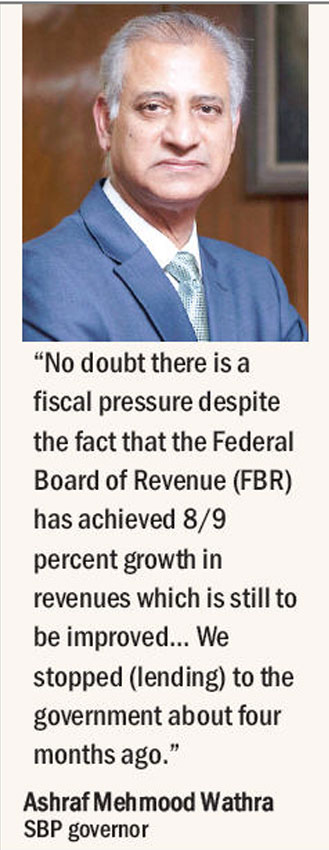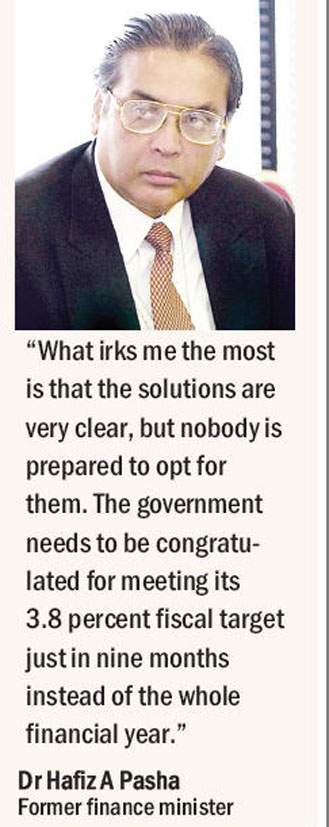 The government’s financial worries are rapidly worsening despite borrowing heavily from banks, including the State Bank of Pakistan (SBP). The issue is getting compounded due to the increasing fiscal deficit, which, some fear, may reach up to 4.3 percent (over Rs2 trillion) of the GDP by June 30 this year.
The government’s financial worries are rapidly worsening despite borrowing heavily from banks, including the State Bank of Pakistan (SBP). The issue is getting compounded due to the increasing fiscal deficit, which, some fear, may reach up to 4.3 percent (over Rs2 trillion) of the GDP by June 30 this year.
There is a growing consensus in the concerned quarters that year 2017-18 will bring growing financial difficulties for the present government, as the situation on both the internal and external fronts is turning serious and posing threats to the controversial economic stability the government says it achieved after four years of hard work.
Now, when the fiscal deficit has already reached 3.8 percent of the GDP in the first nine months of 2016-17 and trade deficit is surging to an all-time high at $23.385 billion, federal planners are reportedly failing to find remedies to escape what many believe as the crisis of a grave magnitude.
Following the 12th and the last review by the International Monitory Fund (IMF), it was agreed that the annual fiscal deficit target for 2016-17 will be Rs1,250 billion, equivalent to 3.8 percent of the projected GDP.
It was fixed at Rs557 billion for the first half of 2016-17. The actual outcome, according to the ministry of finance is almost Rs800 million. Therefore, the fiscal deficit has already been exceeded by Rs243 billion or over 0.7 percent of the GDP. However, after the recent Article IV Consultation, the IMF has projected the annual deficit at 4.1 percent of the GDP, only 0.3 percent of the GDP above the target.
This is presumably based on strong fiscal performance in the 2nd half of 2016-17. Indications are that in the third quarter, the fiscal deficit has increased further by another Rs400 billion. Bank borrowings have increased by Rs320 billion. Borrowings from the central bank have reached the record level of Rs914 billion. Non-banking borrowings and external borrowings have increased by almost Rs80 billion. Therefore, the total fiscal deficit in the first nine months of 2016-17 has already crossed Rs1,200 billion.
A new worrying development is the extraordinary jump in bank borrowing by public sector enterprises (PSEs) to Rs173 billion, as compared to only Rs12 billion last year by end March 2016. Bulk of the borrowing is said to have been given as guarantees by the Ministry of Finance. Effectively this should be treated as part of the fiscal deficit. As such, the fiscal deficit has already exceeded the annual target of Rs1,250 billion. It should have been Rs818 billion, according to the agreement with the IMF.
 The way things are going, the annual deficit in 2016-17 is likely to reach Rs2 trillion, almost six percent of the GDP. In absolute terms, if this happens, it will be the largest annual fiscal deficit in the history of Pakistan. Public debt to GDP ratio, according to a broader definition, could reach 70 percent of the GDP, way above the limit of 60 percent imposed by the FR & DL Act of 2005.
The way things are going, the annual deficit in 2016-17 is likely to reach Rs2 trillion, almost six percent of the GDP. In absolute terms, if this happens, it will be the largest annual fiscal deficit in the history of Pakistan. Public debt to GDP ratio, according to a broader definition, could reach 70 percent of the GDP, way above the limit of 60 percent imposed by the FR & DL Act of 2005.
The fundamental question is why the public finances have deteriorated so much this year. The following factors are contributing to the larger deficit:
• FBR, revenues have fallen short by over Rs180 billion in the first nine months.
• Federal non-tax receipts are below target by over Rs220 billion due to lower CSF inflows, smaller SBP profits and lower income from dividends. Also 4G auction is still to take place.
• The increase in salary bill and pensions of Rs57 billion was not budgeted for in 2016-17 Budget Estimates.
• The federal PSDF releases as of end – March 2017 are higher by 38 percent or Rs150 billion, in relation to last year.
Former finance minister Dr Hafiz A Pasha and central bank governor Ashraf Wathra are in full agreement that the rising fiscal deficit is a serious issue and should not go unnoticed.
For Dr Pasha, ballooning twin deficit was a key cause of alarm that warranted solicitous approach to manage things to work out a sustainable budget for the next financial year. “What irks me the most is that the solutions are very clear, but nobody is prepared to opt for them. The government needs to be congratulated for meeting its 3.8 percent fiscal target just in nine months instead of the whole financial year,” he said satirically.
He said that fiscal deficit is increasing because of the government’s recklessness. “It is regrettable that deficit financing - printing of currency notes – to the tune of Rs900 billion was made and it all happened after September 2016 when Pakistan ended its three years programme with IMF,” the distinguished economist said.
The former finance minister said funds for hydro-electric projects used to be paid from the budget, which was no more the practice. For example, he said the previous Pakistan Peoples’ Party (PPP) government paid Rs25 billion to the Khyber Pakhtunkhwa government on account of hydro-electric payments, but the Pakistan Muslim League-Nawaz (PML-N) government made Rs172 billion such payment out of the budget. “This may ultimately lead to 4.3 percent of fiscal deficit of the GDP in 2016-17.”
Governor of the central bank of Pakistan Ashraf Mehmood Wathra conceded that fiscal deficit was estimated to be 4.1 percent of GDP against the target of 3.8 percent set for the current financial year. “No doubt there is a fiscal pressure despite the fact that the Federal Board of Revenue (FBR) has achieved 8/9 percent growth in revenues which is still to be improved.”
So far, revenue collection was not all that bad and hopefully the FBR would manage adequate revenues by June this year, and eventually shortfall would range between Rs100 to Rs150 billion which is a usual phenomenon.
He said his bank was no more offering borrowing to the federal government and the recommended course of action was to curtail Public Sector Development Programme (PSDP) spending and other undue expenditure to ensure minimum fiscal deficit. “We stopped (lending) to the government about four months ago,” the articulate Wathra said, and added he was sure that the government should be taking notice of the issue.
He too was critical of the increasing trade deficit and said the exports would have to be increased and imports cut to narrow down the growing trade gap. The issue of exporters’ refunds needed to be resolved to help remove their liquidity crunch.
He agreed that exports and home remittances were two main areas of concerns that required a collective approach to be adopted by both the exporters and the ministry of finance/central bank.
Wathra, nonetheless, did not believe that the future government would have to go back to the IMF for emergency lending as was being feared by experts and independent economists. Today, the situation, he claimed, was much better than what was four years ago, therefore, there was no need for alarm. “We do face challenges and the government is trying to tackle them,” he added.
The word has it that Prime Minister Nawaz Sharif has for first time taken notice of the falling exports – courtesy some of his well-wishers - whose advice sometimes he takes seriously. It is perhaps in this backdrop that Younus Dagha, who earlier served as secretary water and power, was appointed secretary commerce to replace the incumbent Azmat Ranjha with a view to increase exports and restrict imports which have in fact doubled and are creating an unparalleled trade gap.
Usually people do talk about what they term overstated GDP growth rate, overstated foreign inflows, and overstated non-tax revenue. Particularly with respect to the auction for 3G license scheduled May-end this year budgeted to generate 75 billion rupees but now expected to generate Rs32 billion and the government’s failure to clear export refunds.
 As a matter of fact, the situation began to go soar when Mr Dar claimed to have achieved 4.6 fiscal deficit as opposed to 8.8 percent witnessed during the previous PPP government. This deficit, it is said, was shown higher which was 8.2 percent and not 8.8 percent of the GDP.
As a matter of fact, the situation began to go soar when Mr Dar claimed to have achieved 4.6 fiscal deficit as opposed to 8.8 percent witnessed during the previous PPP government. This deficit, it is said, was shown higher which was 8.2 percent and not 8.8 percent of the GDP.
 On the external front, the current government’s failure in privatising the ailing public sector entities has also created problems. In the past three years, the government did not succeed to raise $2 billion by disinvesting various state sector units nor did the state accomplish the much needed restructuring.
On the external front, the current government’s failure in privatising the ailing public sector entities has also created problems. In the past three years, the government did not succeed to raise $2 billion by disinvesting various state sector units nor did the state accomplish the much needed restructuring.
Questions have piled up as to what happened to the privatisation of the 30 fast track public sector enterprises. Also, bigger corporations like Pakistan International Airlines, Pakistan Steel Mills, and Pakistan Railways continue to incur losses. Who should be held responsible for the failure of these state sector entities?
Why was the PML-N’s minister for privatisation Muhammad Zubair Umar appointed as the governor of Sindh? Has he delivered on the privatisation front or was he rewarded for impatiently defending the government throughout his term as the federal minister on both print and electronic media.
The fact remains that the privatisation minister was an utter failure when it comes to finalising any transactions. His interest seems to have been only to appease the prime minister, who then felt obliged to appoint him as the governor, despite concerns expressed by many within the ruling party.
Going forward, political expediency would not help overcoming serious economic challenges. Reserves have already started facing pressure after the government made over $2 billion repayments. Home remittances have also become another worrying issue that seeks full attention of the Ministry of Finance and the central bank. There is need to formulise a way so as to receive most of these remittances through the official banking channels and not through the infamous hundi and hawala transactions during the remaining three months of 2016-17 and beyond.
“No doubt there is a
fiscal pressure despite the fact that the Federal Board of Revenue (FBR) has achieved 8/9
percent growth in
revenues which is still to be improved... We stopped (lending) to the government about four months ago.”
Ashraf Mehmood Wathra
SBP governor
“What irks me the most
is that the solutions are very clear, but nobody is prepared to opt for them. The government needs to be congratulated for meeting its
3.8 percent fiscal target just in nine months
instead of the whole
financial year.”
Dr Hafiz A Pasha
Former finance minister
The writer is a senior journalist based in Islamabad